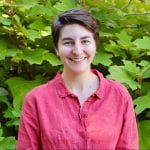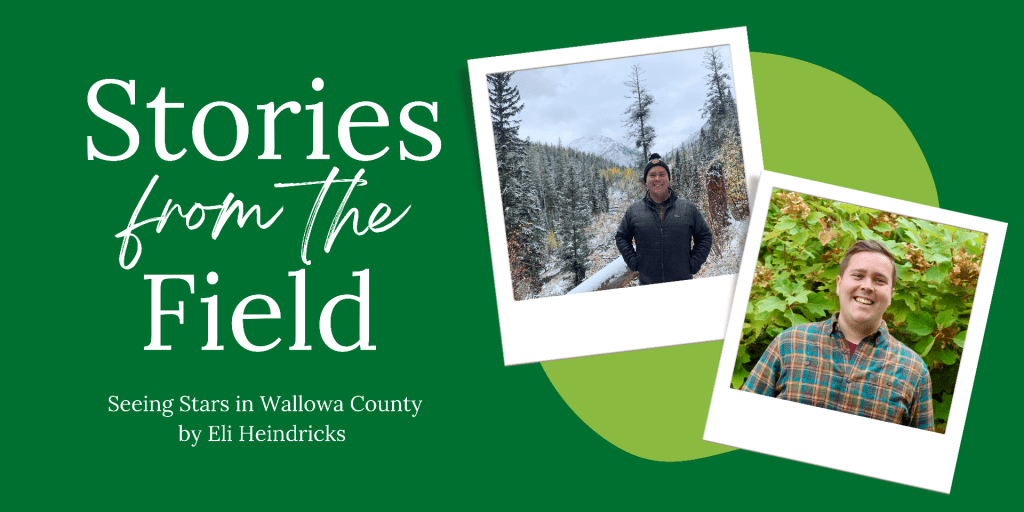by Augusta Stockman, Destination Development Coordinator, Willamette Valley Visitors Association
“Not a bad view, huh?”
All I could do was nod because of the piercing cold and hypnotic view. Stretching out in front of me were dense forests, some smoke from a couple late-season controlled burns, and the faint, but unmistakable, snow-capped peaks in the distance that never fail to stir my East Coast heart. It was legitimately a breathtaking panorama. I looked down at the steep terrain falling away from our lookout point, grateful for my two feet planted squarely on the ground and marveling at the fact that it was slated for mountain bike trail development.
 I was there with another RARE member and their supervisor to get a tour of the proposed recreation site. What most delighted us was that we were getting the inside scoop from an avid mountain biker and community leader himself— who had been, not thirty minutes earlier, in a meeting with us to discuss the project. We passed him as he pedaled like a perpetual motion machine. He joked that he would see us at the top, despite our obvious transportation advantage in our rugged, all-wheel-drive vehicle, but we soon realized he was not actually joking. He looked more robot than human at that point.
I was there with another RARE member and their supervisor to get a tour of the proposed recreation site. What most delighted us was that we were getting the inside scoop from an avid mountain biker and community leader himself— who had been, not thirty minutes earlier, in a meeting with us to discuss the project. We passed him as he pedaled like a perpetual motion machine. He joked that he would see us at the top, despite our obvious transportation advantage in our rugged, all-wheel-drive vehicle, but we soon realized he was not actually joking. He looked more robot than human at that point.
I was equally star struck because several months earlier, I had been forwarded a news article to help understand the context and history around recreational developments in this part of the Willamette Valley. The article included in-depth interviews with this same community leader during his time as a county commissioner, highlighting his commitment to outdoor recreation in the face of political and often personal backlash. And now here he was, huffing and puffing like a bellows, dismounting his bike to geek out with us about what this site will mean for the community and the future of local cycling. Holding all of that together was a moment of clarity and affirmation for me.
I serve as Destination Development Coordinator with the Willamette Valley Visitor Association (WVVA), getting to tackle various projects focusing on outdoor recreation throughout the region. I have struggled at times to understand and define not only my role but that of the organization, where we fall in Oregon’s complex tourism landscape. Over and over I have been told that we CONVENE. As the regional tourism entity, we convene our local partners, letting them be the boots on the ground but filling in gaps where needed and doing strategic planning behind the scenes.
On a day-to-day basis, that looks like a lot of emails, agendas, and follow up. Sometimes I look around and worry I am not doing enough; wonder what I am adding. I don’t have daily, personal engagement with community members, I do not attend many events, and I often identify tasks just to pass them off to partners. It can feel detached, distant, and intangible. The flurry of in-person orientations and familiarization tours (“fams”) that characterized my first few months of service have trickled to a stop, and the less glamorous work is in full session. As a fresh college graduate, too, I have no basis for comparison.
What was falling into place for me that day on the mountain was a more concrete sense of what this work can actually look and feel like: what all that email correspondence can translate to on the ground. From my stellar vantage point, trying not to shiver uncontrollably, I reflected on the day. That morning I had been in a meeting room in downtown McMinnville with about a dozen community member we had identified for a different, potential new project. The meeting was the culmination of months of internal discussion, planning, and grant writing. The idea itself started long before my RARE term of service. Seeing everyone actually gathered in the room together was incredibly satisfying—so this was convening! We had successfully convened. We would convene again.
It is still one of my favorite days of service so far. I felt plugged in, engaged, gratified. I come back to it when I need a reminder that those feelings are always there, even on the days when I am just behind a desk, working through the to-do list. The pace of this work is not fast. It moves in stops and starts, and I think often of the phrase “hurry up and wait”. There are rhythms of planning, organizing, convening, and reassessing. It is not predictable, and it demands flexibility and patience. In the end it is worth it for those moments of connection, those glimpses of impact, the cold mountain air and the thrill of a project being realized.
 About the author, Augusta Stockman: Augusta grew up in Mid-Coast Maine before attending Vassar College in Poughkeepsie, NY. She graduated in 2023 with a B.A. in Sociology and a minor in Hispanic Studies. Having lived in a small, rural, tourism-dependent town and seen firsthand the complex dynamics between visitors and locals, Augusta is driven to understand how the trends she has seen at home are playing out elsewhere. An avid runner and outdoor frolicker, Augusta is excited to experience all Oregon has to offer. She feels lucky that her RARE position allows her to get to know and learn from a wide array of communities in the state.
About the author, Augusta Stockman: Augusta grew up in Mid-Coast Maine before attending Vassar College in Poughkeepsie, NY. She graduated in 2023 with a B.A. in Sociology and a minor in Hispanic Studies. Having lived in a small, rural, tourism-dependent town and seen firsthand the complex dynamics between visitors and locals, Augusta is driven to understand how the trends she has seen at home are playing out elsewhere. An avid runner and outdoor frolicker, Augusta is excited to experience all Oregon has to offer. She feels lucky that her RARE position allows her to get to know and learn from a wide array of communities in the state.
Interested in gaining community and economic development experience of your own? Are you looking for a life changing experience in rural Oregon? Learn more about serving with the RARE AmeriCorps Program. Applications for Year 31 (2024-25) due April 28, 2024 by 11:59pm PDT.



